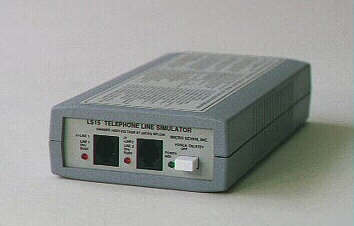Automatic Telephone-line
Tester, model ST10-2
runs with or without PC
-Automatic testing of minimum one, maximum twenty telephone-lines
-Error LED and warning sound generated at internal speaker
-Programmable test interval
-Stand-alone or PC-assisted testing of phone lines
-Testing of incoming lines for fax machines or alarm receivers
Copyrights 2005 2006 Micro Seven, Inc.
Micro
Seven model ST10-2, Automatic Telephone Line Tester, provides automatic testing
of maximum twenty telephone lines by dialing each line for testing whether call
to the line is answered or not. Test failure is indicated on ERROR LED and
warning sound is generated at internal speaker. Failed line is reported to
serial interface in PC. PC-assisted testing mode displays test result and a
text file is generated as a disk file. Telephone numbers are stored in
non-volatile memory in ST10-2, and test will start by itself when there is
power failure. Internal audio monitor is provided to hear the test. The standard
accessories of ST10-2include AC/DC adapter, serial port cable, control
software, and operator’s manual. A carrying case, car-batttery adapter, or 230V
AC/DC adapter is extra. The control software for programming ST10-2 and
PC-assisted test is provided as a standard accessory.

Model ST10-2, Automatic Telephone-Line
Tester
SPECIFICATIONS/
Testing
parameters:
Dialing
DTMF or rotary-pulse method:
DTMF:
0dBm nominal, 50ms on, 50ms pause between digit
Rotary-pulse:
60ms break period and 40ms make period
Call
progress tone detection: -30dBm
Programmable
parameters:
Note:
programmed parameters are stored in ST10-2’s non-volatile memory.
Number
of telephone numbers: 10-20 telephone numbers depending on telephone number
length
Telephone
number length: 10-16 digits long
Testing
intervals: 10 sec to 10 minutes between test
Dialing
telephone numbers: 0, 1, 2, 3, 4, 5, 6, 7, 8, 9, *, #, (space for pause),
"," (2.5 sec delay for PBX)
Receiver
selection: fax machines or Contact ID alarm receivers
Alarm
test message in Contact ID format: programmable
Error
reporting:
When
there is a testing error, Error indicator LED is turned on, and audio warning
is generated at internal speaker in ST10-2. The line error is displayed on PC
screen, and it is saved as a text file.
Front
panel controls:
Power
switch
Power
indicator
Rear
panel controls:
RJ11-C
connector for telephone line.
power
input, 12V input, 800 mA
RS232C connector, 9-pin
D-sub, female
AC/DC
Adapter supplied with CS10: 117VAC +/- 5%, or 220VAC +/- 5%(for 220V
unit)
Dimensions: 19 cm (4")
W x 4.5 cm (1.75") H x 10 cm (7.5") L
Weight: 750g (1.65 lbs.)
Environmental: Operating
temperature with power on: 0 to 35 degree C, Humidity: 85% RH at 35 degree C,
storage temperature and operating temperature without power on
Warranty
Service:
six months limited warranty. Service is performed at the factory, usually
within 5 working days.
Options
and Accessories:
Carrying
case
Car
Battery Adapter
USB
adapter
230V
input AC/DC Adapter (117V input unit is a standard.)
Control
software:
provided as a standard accessory
DTMF dialing
signal power: 0 dBm total for two frequency components, 100 ms on, 100ms
off
Pulse dialing: Break period:
60 ms, make period: 40 ms, inter-digit wait time: 1 sec
Alarm
message signal power: -12 dBm (factory default), 0 dBm with
Control Register bit 7 on
Alarm message
DTMF tone timing: burst ON time: 50 ms (factory default), burst OFF time: 50
ms (factory default), programmable by DTMF register
Handshake tone
and kiss-off tone signal detection: -26dBm minimum (factory default),
-38dBm with x4 gain by Control Register bit 6 off
Audio monitor:
monitoring
receiving signal (handshake tone and kiss-off tone) and transmitted signal (dialing
signal and alarm message), 0.1 watts maximum with internal speaker
RS232C
interface:
1200 baud, no parity, and 8-bit character
ASCII commands without using provided control software:
Telephone
number entry: W44 (n1) (n2) for setting up line number, then enter
D<telephone number-maximum fifteen digits><CR> to program a
telephone number.
for example W4400<CR>D5035551212<CR> for dialing 5035551212 for
line 1. Note <CR> is a carriage return. It is stored in EEROM
(non-volatile memory) in AP15.
Polling
interval entry: M(n1) (n2) (data)<CR>
Continuous/Single polling mode
Alarm message entry: S<fifteen digit long alarm
message><CR>
i.e. S123418313101015<CR>
Note: ST10-2 prepares check sums, so do not enter sixteen digits. When sixteen
digit-long alarm message including check sum is entered, checksum, which is
prepared by ST10-2, will become a wrong one. It is stored in EEROM
(non-volatile memory).
Start alarm
reporting: G
Start
alarm reporting process by dialing the telephone number, receive handshake
tones, transmit alarm messages, receive kiss-off tones and hang up the line. A
carriage return is not needed.
Status
messages from ST10-2 to PC for polling
DIALED
# BUSY
POLLING SUCCESS
MESSAGE
FAILED
CALL
FAILED
Hang-up
command or Abort command: A
Turn off off-hook relay or abort alarm reporting process. A carriage return is
not needed.
Repeat alarm
message command: B
It transmits alarm message when ST10-2 is off-hook condition. A carriage return
is not needed.
Reading
telephone-number command: T
ST10-2 transmits programmed telephone numbers to PC. A carriage return is not
needed.
Reading
alarm-message command: U
ST10-2 transmits programmed alarm message in sixteen digit-long including check
sum to PC. A carriage return is not needed.
Discrete telephone line tester commands: (optional feature)
On-hook
test:
ASCII “O (oh)” for testing loop voltage of greater than 20 volts across Tip and
Ring
Result: messages back to PC, “Loop
Voltage OK” or “No Loop Voltage”.
Off
hook command: “F” for turning off-hook relay on.
Loop
current test: ASCII “L”
Result: messages back to PC, “Loop
Current OK” or “No loop current”.
Dial
tone test: ASCII “N”
Result: messages back to PC, “Dial Tone
OK” or “No Dial Tone”
Dialing: ASCII “P” for
dialing a pre-programmed number.
Ring
signal test: ASCII “R”
Result: messages back to PC, “ Ring
Signal OK” or “No Ring Signal”.
Hang-up
command
: ASCII “A”.
Computer
requirement: Almost any PC with 500k bytes RAM
MICRO
SEVEN, INC., P.O. BOX 5597 BEAVERTON, OR 97006 U.S.A.
PHONE: 503-693-6982, FAX: 503-693-9742
home page: www.microseveninc.com